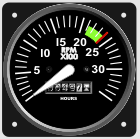
Reduced engine wear and fuel savings can be achieved by lowering RPM and increasing manifold air pressure (MAP) to maintain horsepower and thrust. Modern engines have approved power ranges for which this practice is allowed. These ranges are in the POH but can also be found in the engine manufacturers handbook.
Charles Lindbergh visited the South Pacific in World War II as a civilian representative of an aviation manufacturer. He helped pilots lift higher bomb loads and fly greater distances. He was successful on both counts, achieving greater range mostly through over square and lean of peak operation of the engines.
For example, the P-38 was regarded as having an operational range of about 400 miles; when he left the pilots regarded it as having a 950 mile range, plus combat time over the target and a fuel reserve. However, the P-38 pilots took a lot of convincing that running their engines over square would not cause them to fail early, thereby dropping them in the vastness of the Pacific with little change of survival.
These pages will talk about the advantages of running oversquare on your aircraft engine(s) which will result in lower operating cost in the form of a lower fuel consumption, maintenance...etc.
我们将讨论为什么oversquare运行not harmful to the engine, you can think of it as switching to a higher gear as is done in a car. Obviously, this is for engines equipped with a controllable propeller.
Oversquare means having the MAP higher than RPM divided by 100. Thus a MAP of 25" and a RPM of 2300 is such a situation. In case ofturbocharged enginesthey are almost always run oversquare, for example: The Lockheed Super Constellation runs on a MAP of 51" at takeoff with 2900 engine RPM and cruised with 44" and a much lower engine (2600) RPM.

A turbo normalized engine has a lower manifold pressure (MAP) compared to a turbo charged type (usually around 30-32 inch) which is kept constant until a certain altitude. The engine RPM is set at 2700 at takeoff and in the range of 2200-2500 RPM during cruise. And even in this situation you are running oversquare with a normalized engine.
Another example is your everyday Cessna 172 with an O-320 or O-360 engine and a fixed pitch propeller: RPM during initial takeoff is around 21-2200 (this will rise when airspeed increases during takeoff roll) and MAP is about 29-30 inch, a good illustration of an oversquare situation.
This means that any type of aircraft with a fixed pitch prop and a static propeller RPM around 2200 with full throttle (max MAP) runs oversquare. When taking off the MAP will be 29-30 inch and the RPM around 2200. On each and every takeoff that engine runs in an oversquare condition but actually no harm is done.
Combining all the facts shows that running your engine with a lower RPM/100 than MAP has a number of advantages:
These advantages will result in longer engine life and lower fuel and maintenance bills. Things every pilot and aircraft operator will appreciate in these days of high fuel prices!
Written by EAI.